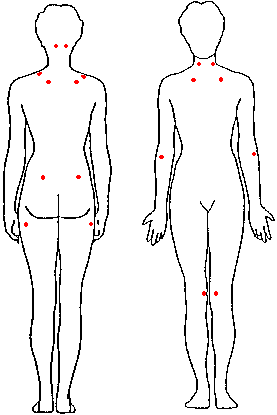Fibromyalgia
5 Hours Continuing Education
Carolyn McMakin, M.A.,D.C.
Private Practice
Portland, Oregon

Most
commonly noted Tender Points
| Midpoint upper trapezius |
84-90% |
|
| Medial fat pad of the knee |
74-90% |
|
| 2 cm distal to the lateral epicondyle |
62-86% |
|
| Upper gluteal area, below iliac crest |
60-65% |
|
| Midpoint SCM |
46-65% |
|
| Just distal to medial epicondyle |
50-57% |
|
| 2nd costochondral junction |
32-42% |
|
Symptoms: Wolfe (1990)
| Widespread Pain |
97.6% |
| 11/18 Tender Points |
90.1% |
| Fatigue |
81.4% |
| Morning Stiffness |
77.0% |
| Sleep Disturbance |
74.6% |
| Paresthesias |
62.8% |
| Headache |
52.8% |
| Anxiety |
47.8% |
| Dysmenorrhea |
40.6% |
| SICCA (dry eye) Symptoms |
35.8% |
| Prior depression |
31.5% |
| Irritable Bowel Syndrome |
29.6% |
| Urinary urgency |
26.3% |
| Raynaud's |
16.7% |
Other symptoms found listed in various papers: affective dysfunction, articular pain, subjective (objectively undetectable) swelling of the hands/knees/feet, reticular skin discoloration, dizziness, memory problems, difficulty with concentration, rashes, chronic itching, allergic rhinitis, multiple environmental and chemical sensitivities, hypersensitivity to heat and cold.
Associated disorders:
- Migraine and non-migraine headache (28-58%)
- Irritable bowel syndrome (34%-53%)
- Raynaud's syndrome (30%)
- Mitral valve prolapse
- Chronic Fatigue
Diagnostic Features:
- Predictable pattern of tender points which may be elicited by palpation
- 11 out of 18 potential tender points (Tender to less than 4 lbs./in)
- Chronic non-restorative sleep pattern
- Present for at least three months
Fibromyalgia is no longer a diagnosis of exclusion. The more associated symptoms from Wolfe's list, the more secure the diagnosis.
© copyright
1997

